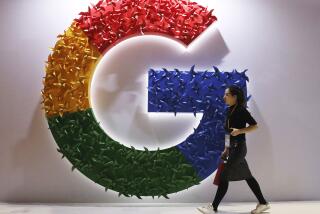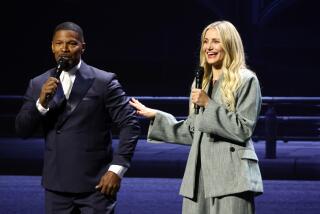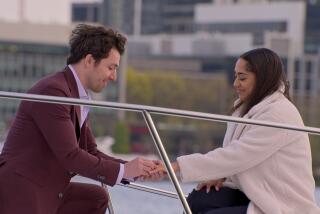Online video distributors gather to court advertisers
- Share via
NEW YORK — Yahoo Inc.staged its glitzy presentation for advertisers in a theater near Central Park, with appearances by Katie Couric, “CSI” creator Anthony E. Zuiker and, via video, Tom Hanks.
AOL Inc.rented out a three-story production studio in the gentrified Meatpacking District, which it filled with pounding dance tracks as gym-sculpted servers carried trays of beverages and snacks. A series of celebrity-studded presentations concluded with 1970s TV star Marlo Thomas taking the stage as AOL awarded prizes, including a new Ford Mustang convertible.
Google Inc.’sYouTube will take the stage Wednesday night at the Beacon Theatre on Broadway, in front of an audience of 2,000 or more.
The nation’s five major online video distributors — which also include Microsoft Corp.and Hulu — have gathered in New York for their first-ever coordinated presentation to advertisers at the Digital Content NewFronts. Each is showcasing professional-grade content with high production values and big-name celebrities in events that occurred alongside similar presentations from cable networks MTV, Oxygen and Syfy.
The underlying message: America’s advertising community should stop associating Internet video with talking oranges and skateboarding dogs and instead think of it as on par with TV. Couric, for instance, is launching a weekly series about health, nutrition and wellness on Yahoo called “Katie’s Take.”
The tech companies are taking a page from the Big Four TV networks, which every spring woo advertisers with lavish million-dollar presentations and parties to showcase their fall prime-time schedules. Zenith Optimedia estimates that marketers spent some $58 billion last year for all TV commercial air time. By contrast, online video advertising was a slender fraction of that sum, and the Internet giants believe they deserve more.
“What I think has been driving people crazy on the digital side — we’ve all seen these charts which show time spent on the Internet versus where the [ad] spend is going,” said Lloyd Braun, former chairman of ABC Entertainment and co-founder of BermanBraun, an independent media company that develops TV and digital programs and feature films. “There’s this huge gap.”
In 2012 online video advertising is expected to exceed $3 billion, according to researcher EMarketer. That’s a nearly 55% increase over last year. It’s on track to reach $9.3 billion by 2016.
Last week, in events held all over Manhattan, Yahoo, AOL and others sought to underscore the similarities between TV shows and original Web series — and spotlight the most glittery of the new digital programs.
AOL, for instance, debuted 14 channels of news and lifestyle programming featuring such personalities as supermodel Heidi Klum, “Project Runway” judge Nina Garcia and former Bravo TV”Top Chef” semifinalist Sam Talbot. Online music service Vevo unveiled an MTV-like slate that included “Busk or Bust,” in which contestants sing for their supper.
Even OK Go’s lead singer Damian Kulash appeared at an ad-agency-organized gathering to extol the virtues of such entertainment underwritten by brands — as was the case with his band’s music video for “Needing/Getting,” parts of which were used in a Super Bowl ad for the Chevy Sonic.
“The Internet industry could have only dreamed of a week like this a few short years ago,” Yahoo Executive Vice President Ross Levinsohn said. “We gathered the decision makers in marketing and advertising in one room to unveil slates of ... original programming. With tens of billions of dollars in advertising spending represented in the room, it is a small price to pay to capture the Holy Grail of TV ad spending.”
Last yearGeneral Motors Co., the third-largest Internet advertiser, spent more than $270 million for online advertising, according to Kantar Media — up 15.7% from 2010. Those numbers probably will rise as the automaker searches for ways to stay connected with consumers, who increasingly skip past traditional television commercials.
“We’re spending more money every year — and exponentially more money buying advertising in places like Hulu, because that’s TiVo-proof,” said Craig Bierley, director of advertising and promotions for GM’s luxury brand Buick. He said the company was looking online for “innovative, interesting ways to create content above and beyond just ‘Come buy my car.’”
One advertising executive pronounced the event a coming of age for digital media, fueled by online video distributors’ investment of hundreds of millions of dollars in content to attract advertisers.
“There are a lot of players trying to grab a relatively small piece of the pie,” said Greg Kahn, executive vice president and business development director for Optimedia International, an ad-buying firm that represents advertisers such asT-Mobile, L’Oreal, Denny’s, Bridgestone andWalt Disney Co.”The Internet companies are not going to take a huge chunk of the TV money, but they will take some.”
The quality of the NewFronts presentations, however, was uneven. Some did not match the polish of a television upfront.
Eschewing pomp, Microsoft held its NewFronts presentation at its midtown Manhattan sales office. The company’s star power consisted of Olympic gymnast Dominique Dawes, NBC News correspondent Kate Snow and “The Guild” Web series creator Felicia Day.
Yahoo’s event in the Florence Gould Hall Theater, whose stage usually hosts performances of the ballet, set a different tone. And Yahoo’s Levinsohn wasn’t shy about touting his company’s entertainment offerings to brands and ad buyers.
“We’re digging in and we’re going to create some bad-ass content for you,” Levinsohn said. “Spend some money.”
Times staff writer Meg James contributed to this report.
More to Read
Inside the business of entertainment
The Wide Shot brings you news, analysis and insights on everything from streaming wars to production — and what it all means for the future.
You may occasionally receive promotional content from the Los Angeles Times.










